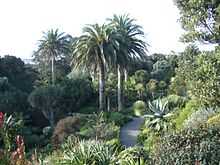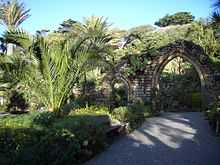Tresco Abbey Gardens
Coordinates: 49°56′52″N 06°19′57″W / 49.94778°N 6.33250°W


Tresco Abbey Gardens are located on the island of Tresco in the Isles of Scilly, United Kingdom. The 17 acre gardens were established by the nineteenth-century proprietor of the islands, Augustus Smith, originally as a private garden within the grounds of the home he designed and built.
Tresco Abbey
Augustus Smith chose Tresco as the site of his home because the site was more or less central in relation to the rest of the islands. It is also close to the original abbey ruins, is near a fresh water pool and overlooks the sand dunes and beach at Carn Near. The area at the time was barren land and the original building, designed by Smith and started in 1835, was small in comparison to the current building. He made additions to the house in 1843 and 1861. The Grade II listed house consists of roughly coursed granite with ashlar dressings and a slate roof. Some of the timbers from the 1861 wreck of the Award were used for the panelling and roof of the new dining room, as well as panelling of the rooms Annet, Rosevean and Rosevear.[1] His successor, Thomas Algernon Smith-Dorrien-Smith added the tower in 1891.[2][3]
Abbey Gardens
When Augustus Smith chose the area for his house and garden one of his first acts was to build a granite wall for shelter and to scatter gorse (Ulex europaeus) seeds. The seeds were brought from the mainland which suggests that the main gorse plant on the islands was western gorse (Ulex gallii) which, being a low growing plant, would not provide as much shelter.[4] Within the gardens are the remains of a Benedictine abbey founded in 964 AD, although the majority of what remains today comes from the Priory of St Nicholas founded by monks from Tavistock Abbey in 1114.[5] There were hardly any trees on the island and the gorse did not provide enough protection so he planted shelterbelts. The first were mainly deciduous trees such as, elm (Ulmus sp), sycamore (Acer pseudoplatanus), oak (Rubus sp) and poplar (Poplar sp), and later he planted Monterey cypress (Cupressus macrocarpa) and Monterey pine (Pinus radiata) which are fast growing and suited to coastal conditions.[6]
Because of the mild winter climate, the long hours of summer sunshine, and the high walls and hedges around the garden protecting it from the Atlantic winds, the garden is now home to exotic plants from all over the world: the Mediterranean, South America, South Africa and Australasia.[7]
Valhalla collection
The Valhalla collection is within Tresco Abbey Garden containing some 30 figureheads, as well as name-boards and other decorative carvings from the days of sail. The collection was started by Augustus Smith. Most of the figureheads date from the middle and end of the 19th century and come from merchant sailing vessels or early steamships that were wrecked on the Isles of Scilly.[8] Some of the ships which are represented in the collection are:
- a 17th-century stern decoration of the Greek god Boreas and possibly carved by Pierre Puget, is said to be from a French ship wrecked on Annet in that century.[9]
- SS Thames — wrecked 4 January 1841 near Gorregan and Rosevear.
- Alessandro II Grande — wrecked 1 January 1851 when she was blown on the Mare ledges, off the south shore of Tresco. There was no loss of life. The figurehead is of Tsar Alexander I.[10]
- Mary Hay — wrecked 13 April 1852 after hitting the Steeple Rock, on the Bream Ledges which is between Mincarlo and Samson.[11]
- Chieftain — said to be wrecked in 1856 off St Martin's Head. There is no record of a ship with that name in the Lloyd's Register[11]
- Award — wrecked 19 March 1861 when she was driven onto Gweal during a force 8 to 9 NNW gale. Her crew of 24 managed to scramble ashore.[1]
- Primos — wrecked 24 June 1871 on the Seven Stones reef.[11]
- River Lune — wrecked 27 June 1879 on the Brothers Rock in Muncoy Neck, between Melledgan and Annet.[11]
- Bernardo – sank on Annet in 1888. Her figurehead is said to be St Bernard of Clairvaux.[12]
- Lofaro — wrecked 2 February 1902 struck Merrick Rock, St Martin's with the loss of her crew.[11]
See also
References
- ↑ 1.0 1.1 "Valhalla - Award 1861". Tresco Estate. Retrieved 5 November 2013.
- ↑ Vyvyan, Clara C (1960). The Scilly Isles. London: Robert Hale.
- ↑ "Tresco Abbey". English Heritage. Retrieved 5 November 2013.
- ↑ Parslow, Rosemary (2007). The Isles of Scilly. London: Harper Collins.
- ↑ Lane, Charles Arthur (1892). "Descriptive Lantern Lectures on English Church History". Religion. p. xvi.
- ↑ King, Ronald (1985). Tresco: England's Island of Flowers. London: Constable & Company Limited. ISBN 0-09-466170-7.
- ↑ "Welcome to the Abbey Garden". Tresco Island. Retrieved 2013-09-08.
- ↑ Taylor, James. The Maritime Trust Silver Jubilee, 1969-1994. The Maritime Trust.
- ↑ "Valhalla - Boreas". Tresco Estate. Retrieved 6 November 2013.
- ↑ "Valhalla - Alessandro Il Grande 1851". Tresco Estate. Retrieved 5 November 2013.
- ↑ 11.0 11.1 11.2 11.3 11.4 Larn, Richard (1992). Shipwrecks of the Isles of Scilly. Nairn: Thomas & Lochar.
- ↑ "Valhalla - Bernardo 1888". Tresco Estate. Retrieved 6 November 2013.
| Wikimedia Commons has media related to Abbey Gardens, Tresco. |